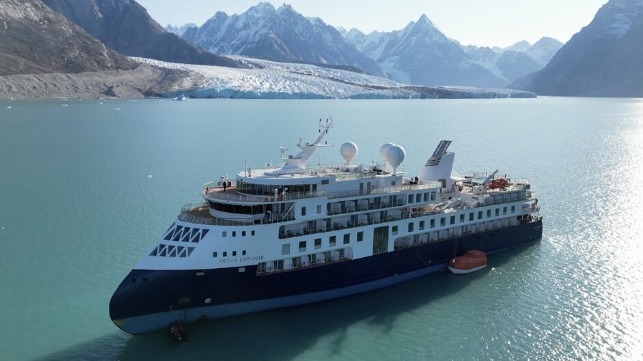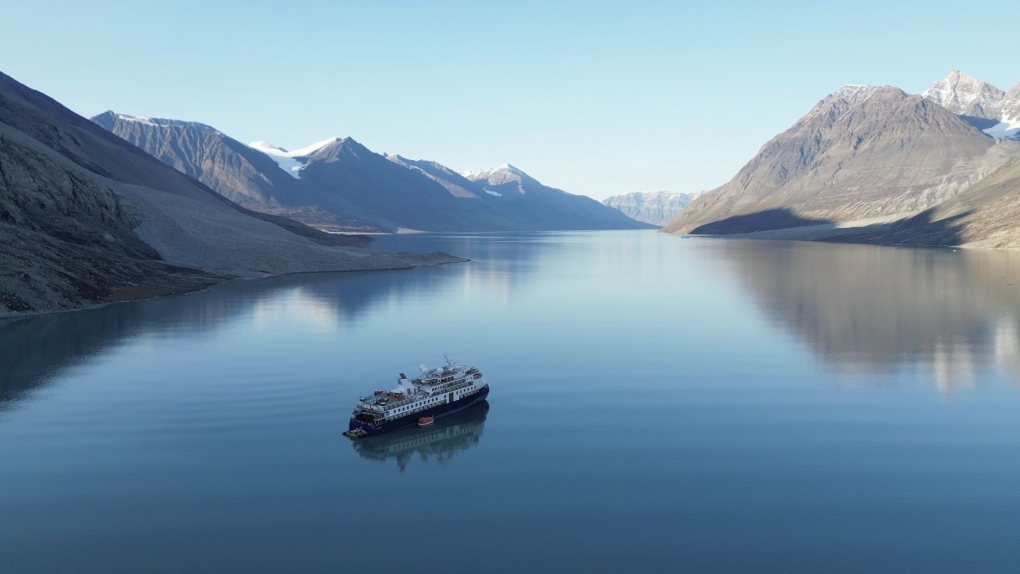 Ocean Explorer remains aground after attempting to free itself and a fishing boat attempted to pull it free (SIRIUS/Arctic Command photos)
Ocean Explorer remains aground after attempting to free itself and a fishing boat attempted to pull it free (SIRIUS/Arctic Command photos)Staggeringly beautiful, but treacherous and highly dangerous in the wrong circumstances, the relatively unexplored coast of Greenland has become one of the most sought-after prizes for expedition cruises.
In the maritime world, this Danish territory is one of the remotest places on earth, with vast swathes of its eastern coastline uncharted, leading mariners to note ironically that the surface of the moon has been better documented than the waters around these parts.
In the maritime world, this Danish territory is one of the remotest places on earth, with vast swathes of its eastern coastline uncharted, leading mariners to note ironically that the surface of the moon has been better documented than the waters around these parts.
Alpefjord in the GeoGarage platform (DGA nautical raster chart)
But the thrill of sailing into such an unknown wasteland, populated by polar bears and musk oxen, is a key part of its appeal for the new generation of expedition cruise ships now venturing into this isolated region.

The MV Ocean Explorer, a Bahamas-flagged Norwegian cruise ship with 206 passengers and crew, which has run aground in northwestern Greenland is seen on Tuesday, Sept. 12, 2023.
(SIRIUS/Joint Arctic Command via AP)
This week’s news that expedition ship Ocean Explorer has run aground in Alpefjord, high up on Greenland’s east coast in the Northeast Greenland National Park – an area that is almost the size of France and Spain combined and with no permanent human habitation – struck a personal chord with me.

Cruise ship that charges $33,000 per person is stuck in Greenland’s Arctic
CREDIT: DANISH AIR FORCE/ARCTIC COMMAND
I was in the vicinity just a few weeks ago aboard luxury expedition ship Seabourn Venture that departed Iceland’s capital Reykjavik to explore Greenland’s eastern and western coasts during an unforgettable two-week voyage.
Our first stop was Scoresby Sound, which sits slightly south of Alpefjord, bordering the southern flank of the national park.
This network of giant fjords stretching for 68 miles dwarfs its better-known contemporaries in Norway, with towering cliffs hundreds of feet high, separated by azure ribbons of glaciers and vast winding waterways.
source : Maritime Bulletin
Due to this summer’s heavier than usual ice floes, caused by a greater amount of ice breaking away from the Greenland Ice Sheet, which covers nearly 80 per cent of the landmass (an area three times the size of Texas), ours was the first ship to enter the fjord system this year as it was previously icebound.
What greeted us was a study in frozen magnificence, with icebergs majestically floating like a procession of giant sculptures carved into intricate shapes by the elements.
For Seabourn Venture’s British captain Simon Bishop and his bridge team, such beauty is laced with potential peril, commanding vigilance at all times.
Explaining the lack of nautical charts detailing Greenland’s east coast, he explained: “We are dealing with data from the 1960s, mainly because the infrastructure of the east coast is poor so there is a lack of detail.”
Mighty glacier in the Alpe Fjord, East Greenland
While Greenland’s west coast is covered by more thorough digital navigational aids, Seabourn Venture’s bridge crew plotted its eastern route by pencil using a traditional paper chart which showed only limited routes through Scoresby Sound where the channels and depths were recorded.
Having been launched by US line Seabourn last year, Seabourn Venture has the latest technology to help it navigate these areas and is one of the first ships equipped with a special ice radar to help it to detect such hazards.
Another tool at its disposal is a forward-looking sonar, which enables the ship to enter uncharted waters. This works with a Zodiac boat sailing ahead of the ship, carrying a special wide-angle multibeam camera that scans and maps the seabed, creating 3D images transmitted straight to the bridge.
On our voyage, it enabled us to explore uncharted waters on a couple of occasions, but heavy ice floes still meant a planned island stop had to be abandoned as it was considered unsafe.
Wherever we went on this voyage, there was no doubting that safety was always the uppermost concern of the officers and crew.
Travelling on such a ship, where our complement of 181 passengers was surrounded by luxurious touches, with no shortage of caviar and champagne, it is also deceptive, enabling travellers to experience the pristine beauty of this environment while insulating them from the rawness of the elements.
Travelling on such a ship, where our complement of 181 passengers was surrounded by luxurious touches, with no shortage of caviar and champagne, it is also deceptive, enabling travellers to experience the pristine beauty of this environment while insulating them from the rawness of the elements.
There are no shortage of luxurious touches aboard Seabourn Venture
“We are travelling on what is like a spaceship, drinking champagne and in the remotest region of the world, yet in the harshest environment and it is easy to forget this,” said the ship’s expedition leader Fridrik Fridriksson.
How Ocean Explorer, which was sailing for Australian cruise operator AE Expeditions (known outside the UK as Aurora Expeditions), ran aground on Monday afternoon is not known.
This modern ship, launched in 2021, is described as having “the latest cutting-edge technology, sustainability and navigation capabilities”.
A statement from the company said the 206 passengers (mainly Australians, but with some Britons), the expedition team and crew were safe and well and in no immediate danger, with ample supplies.
However, such is the remote location that according to a statement from the Danish military’s Joint Arctic Command, its nearest available inspection vessel Knud Rasmussen was 1,200 nautical miles away and could not reach Ocean Explorer until Friday at the earliest.
JAC’s head of operations, Brian Jensen, is quoted by Reuters as describing the situation as a “worry” as the nearest help was so far away and the weather could be unfavourable.
However, such is the remote location that according to a statement from the Danish military’s Joint Arctic Command, its nearest available inspection vessel Knud Rasmussen was 1,200 nautical miles away and could not reach Ocean Explorer until Friday at the earliest.
JAC’s head of operations, Brian Jensen, is quoted by Reuters as describing the situation as a “worry” as the nearest help was so far away and the weather could be unfavourable.
 Luxury cruises allow passengers to experience the beauty of their environment while being protected from the elements
Luxury cruises allow passengers to experience the beauty of their environment while being protected from the elementsCREDIT: Sara Macefield
“However, in this specific situation, we do not see any immediate danger to human life or the environment, which is reassuring,” he said.
Bloomberg reports that two attempts by the ship to free itself on high tides have failed.
Adventure cruising has been one of the fastest growth areas of the cruise market in recent years with the expanding number of ships equipped with the latest technology pushing back the boundaries of expedition cruising.
According to CLIA, the cruise association, the number of passengers sailing on expedition voyages more than doubled between 2016 and 2022.
Akvile Marozaite, co-founder of the Expedition Cruise Network, said AE Expeditions’ ships are “some of the most technologically advanced ships in the sector” and that the grounding was an “incredibly rare and unlikely event”.
But with an increasing number of ships sailing into ever-more remote regions it raises the question of what happens if and when something goes seriously wrong.
As Captain Bishop said: “The challenges in Greenland are the ice and being so remote. That means we have to be prepared for the unknown.”
Links :
- AP : A cruise ship with 206 people onboard has run aground in Greenland / Stranded luxury cruise ship MV Ocean Explorer has been pulled free at high tide in Greenland
- Maritime Executive : Efforts fail to free cruise ship grounded in remote, Northern Greenland
- Bloomberg : Freed Cruise Ship Shows Risks of More Traffic in Remote Arctic / Luxury Cruise Ship Gets Unstuck After Four Days in Greenland’s Arctic



No comments:
Post a Comment